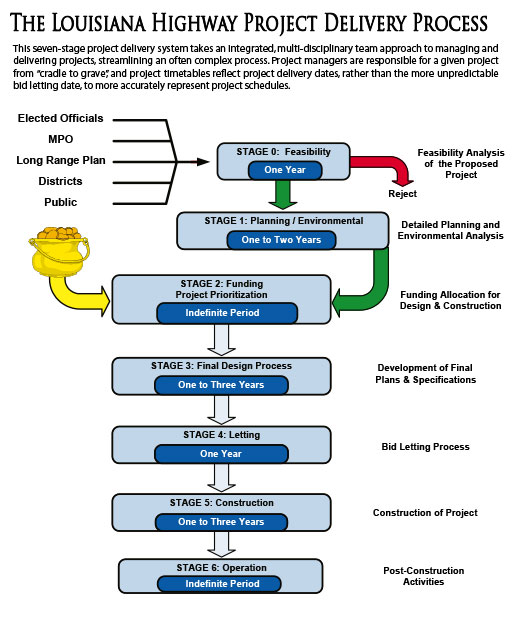October 1, 2019
Elected officials and government employees are often asked “Why do road improvements take so long?”
There are many reasons, and many correct responses because there are numerous steps in the construction or expansion of a street, bike lane, sidewalk, or even road signs or streetlights. The steps vary depending on the size and type of road, what it connects, and where it is located. Many people representing different areas of expertise must contribute their skills and knowledge to the process. The Move Ascension program includes projects for both local (Parish) roads and also State (DOTD) highways. Let’s begin with a summary of the Louisiana Department of Transportation’s “Project Delivery Process” to understand the steps involved in state highways.
Louisiana DOTD Project Delivery Process
State transportation infrastructure improvements typically go through a six-step process before they are “operational” and put into use. These six stages are as follows:
- Feasibility Study: From a generalized “high level” is this particular project feasible? What problem would it solve? What challenges do we think it would face and what do we expect it would cost? (1 year process)
- Planning and Environmental Stage: What routes could this road follow to achieve its purpose? What is located here and how would various routes impact existing features, populations and the environment? What specific tasks must be included in the Scope of Work for this project and what would each cost? How long would this process take? (1-2 years)
- Funding: How will we pay for this? Will the money be available all at once or must we implement this project in stages? The funding process is where political influence often becomes invaluable as public funds are provided, delayed or denied. Every project needs a “champion”. (“Indefinite” period)
- Final Design: Engineers develop final drawings and specifications for the project. Officials obtain the land - the public “right-of-way” necessary to construct the project. (1-3 years)
- Letting: Also called “bidding”, this is the step where contractors examine the plans and specifications, develop their cost break-outs, and submit competitive bids to do the work. (3 months - 1 year)
- Construction: While the public might have seen some flags or markings from land surveyors, construction is the step where we see things “getting done”. The land is graded, utilities may be installed or relocated, and the road project is constructed. (duration depends upon project scope)
Quality and safety inspections are ongoing throughout the construction process, and when final approval is received the project becomes “operational” and traffic starts flowing.
Learn more at Louisiana DOTD’s Project Delivery Process web page.
Local Roads
Local roads are the neighborhood streets, collectors, and sometimes arterials which aggregate traffic and deliver it to state highways. Local roads tend to have fewer lanes and complexities. As a result, the process required to plan, design and build them is often less complex or less formalized than that required for State projects. Beyond maintenance and repair of existing roadways, the need for capacity enhancements are nearly always tied to changes in land use and increased density from urban growth. Often citizen input and local transportation master planning efforts reveal and clarify demand for specific transportation improvement projects. Local officials also identify funding sources for the projects, and rank them by their anticipated benefits. The design and construction process then follows the following steps:
- Land / Topo Survey: Land surveyors conduct the fieldwork necessary to collect dimensions, elevations, and locate existing features on the land. A project corridor is generally defined.
- Subsurface Utility Engineering (SUE): Locating underground utilites (water and gas lines, fiber optics, pipelines, etc.) is a critical step in order to help designers avoid if possible, and mitigate if not, during the design phases. This results in cost and time savings during construction activities.
- Geotechnical Testing: The soil is tested to determine structural stability and other characteristics which influence road bed design.
- Preliminary Design: This is the first attempt at designing the roadway improvements based on the above inputs and guidance from officials, experts, and public comment. Impacts on the environment are assessed.
- Final Design: After the preliminary design is reviewed and additional information revealed, it is usually adjusted to better solve the problem and all aspects of the design are brought to the final stage, including plans and specifications which adhere to all Federal standards and guidelines.
- Right-of-Way Acquisition: Portions of private property must sometimes be required to fit the public roadway safely into the corridor. Room must be allowed to either side for utilities, drainage, safety shoulders, sidewalks, and other public uses.
- Utilities: Utilities may be both underground or strung on poles overhead and are often provided by private companies or cooperatives. These include sewer, water, drainage, electricity, street lighting and telecommunications. The utility relocation process may begin at this stage.
- Public Bid/Construction Letting: The “bid set” of plans and specifications prepared and the project is advertised for public bid to qualified contractors. Responses are received, reviewed, ranked, and if found acceptable an award is made to the winning contractor.
- Construction: Work on the roadway begins often with clearing and grubbing, demolition of existing obsolete structures, grading, and construction of the new road. Inspections occur at intervals through the process to ensure quality and safety.
The time required to accomplish all of the above tasks varies greatly depending on the size of the job, availability of funds and other constraints. Minor improvements to local roads can often be completed quickly by the Department of Public Works, while larger projects involve more parties, greater funding requirements, and therefore more time to complete - often years.
If you haven’t found the answer for your question please feel free to contact us. Our staff will be happy to help you.


